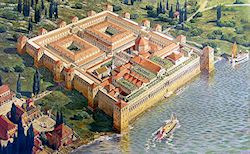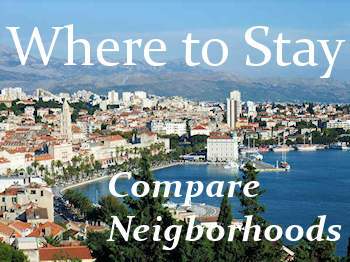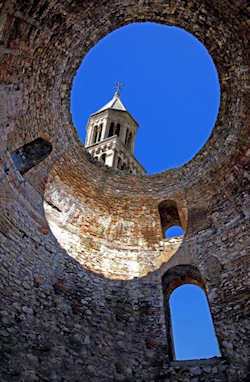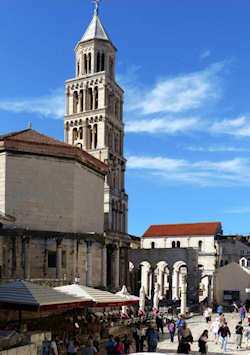This walking tour of Old Split covers all of Diocletian's Palace and the surrounding medieval highlights. Start early and count on a full morning of sightseeing. To follow this tour, see the walking tour map.
Diocletian's Palace
Built by Emperor Diocletian at the end of the third century, the palace was designed to combine the qualities of a villa with those of a fortified military camp. (See more on the history of Diocletian's Palace)
Four sturdy outer walls each have a monumental gate that provides controlled access to the complex. Begin the day with morning coffee at any of the numerous cafes that line the southern facade of the palace, now known as the Riva. It originally rose directly from the water, and boats could enter the complex from the sea. Walk along the riva and find an opening between Nos 22 and 23 to enter the dark underground halls known as the Podrum (1) or basement halls. This cavernous space served as a sub-structure to the palace above, and was probably used for storage. For a small fee, you can visit part of this subterranean space, often given over to plays, exhibitions and special shows. Otherwise, take the main thoroughfare through the Podrum which is lined with stalls selling pictures, ceramics and crafts.
From the Podrum ascend a steep flight of stone steps to arrive at the Peristil (2) In Diocletian's time, this colonnaded square was the principal public space within the walls and the place where Emperor Diocletian appeared to meet his subjects. Lined with Gothic and Renaissance townhouses, the Peristil is still a popular meeting place. During the Split summer festival, the Peristil's stage-set quality forms a backdrop for outdoor opera performances and concerts.
Directly above the Podrum exit stands the vestibule (3). Diocletian's private apartments formed a block along the seafront, and this was the grand entrance into his quarters. The domed roof would originally have been decorated with mosaics, and the walls faced with marble. Groups singing klapa, traditional Dalmatian folk songs, occasionally perform here, taking advantage of the vestibule's exceptional acoustics.
|
After Diocletian's death in 316, his body was enclosed in a sarcophagus and placed in the centre of the octagonal mausoleum The emperor's resting place is now the Cathedral St Domnius(4) which is ironic because Diocletian despised Christianity and instigated the last great period of martyrdom and suffering for Christians. Later inhabitants of the palace converted Diocletian's mausoleum into an early Christian church dedicated to Sv Duje, after Bishop Domnius of Salona, who was one of the many victims of the late emperor's purges.
As you enter the Cathedral note the original wooden doors, which date back to 1214. Carved by Andrija Buvina, a local sculptor, they depict 28 scenes from the Life of Christ. To the right of the cathedral bell tower sits an Egyptian sphinx, made of black granite and dating from 1500BC. The sphinx "guards" the Temple of Jupiter You can climb the magnificent 13th-century Romanesque bell tower. From the top, some 60m (200ft) above the town, you get a better perspective of the urban layout. While the imperial apartments were located on the south side of the palace, overlooking the sea, the north side accommodated soldiers and servants.
Market
From Peristil turn right onto Poljana Kraljice Jelene to head for the city market, known as Pazar (5) Leave the palace through the Srebrena Vrata (Silver Gate), which was discovered and restored in the 1950s, having been concealed behind brick walls for centuries. If you are planning a picnic lunch or just a snack, this is the place to shop. Afterwards retrace your steps through Srebrena Vrata and take the second turning on the right to pass through Poljana Grgur Ninski. Now turn left on Papaliceva, then right on Dioklecijanova, to reach Zlatna Vrata (Golden Gate), which was originally the main entrance into the palace.
Grgur Ninski
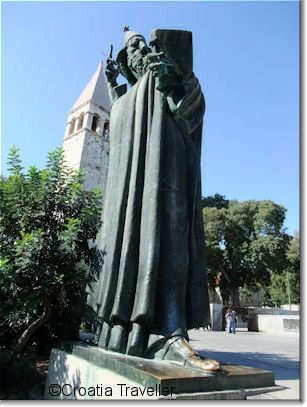
Just outside the gate stands an imposing statue of Grgur Ninski (6) This looming monument was created by Croatia's great sculptor, Ivan Mestrovic, in 1929 to commemorate the 1000th anniversary of the Split synod. Grgur was a 9th-century bishop who challenged Rome by advocating that the Croatian Church use the Slav tongue and Glagolitic script, as opposed to Latin. Rumor has it that if you touch the statue's toe and make a wish it will be granted. You'll recognize the toe immediately as it has been worn to a golden glow.
Narodni Trg
After checking out the statue, follow the path left through the garden, running parallel with the outer walls, then turn left into Bosanska. Follow Bosanska to arrive on Narodni Trg (7) the main town square. In the 11th century, Split began expanding westward past Zeljezna Vrata (Iron Gate) which became the border between the old and new parts of town. In the 14th century this "new town" was fortified and Narodni Trg became the municipal centre.
Trg Brace Radica
Leave Narodni Trg by Maruliceva, a narrow street to your right as you face Zeljezna Vrata and the 15th-century town clock. Follow it to Trg Brace Radica, (8) a small square just one block back from the riva, separated by two octagonal 15th-century towers. In the middle of the square stands a statue of Marko Marulic. His 15th-century play, Judita, is the first play to be written in Croatian. The statue is by Mestrovic.
Fish Market
Walk the length of the square and take Dobric, turn left on Zadarska, then immediately right on Obrov. This will bring you to Ribarnica (9), the indoor fish-market, on Kraj Sv Marije. The peculiar smell hereabouts is not just the fish: next to Ribarnica stands another Secessionist building, dated 1913. Notice a strange smell? That would be the sulphur springs nearby (not open to the public).
Hungry? The fish restaurant, Nostromo, is right next to the market. Here are some more dining options in Split.
Follow this walking tour in a convenient e-book format!
Join the Croatia Traveller Group
Recommended Experiences
©CroatiaTraveller 2005-2024 All rights reserved

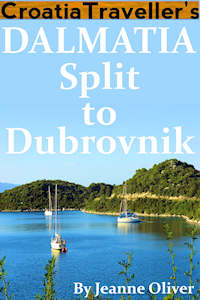
 Walking Tour Map
Walking Tour Map Staying in the Old Town
Staying in the Old Town Split Guide
Split Guide Split Sightseeing
Split Sightseeing Diocletian's Palace
Diocletian's Palace Split History
Split History